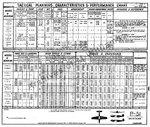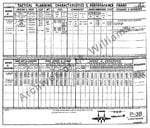I put drgondog's post to a P-38 fanatic and this was his reply:
Left out a few mission types: What about photo/recon, torpedo attacking, dive bombing, strategic level bombing, coastal-shipping attacking, night fighter, strike fighter? There is not one of these roles that the Mustang even comes close to performing as well as the P-38.
Although the P-38 did cost more than the P-51, The above 2:1 ratio is an exaggeration. By war's end, the P-38's price was a little over $97,000 while that of the P-51 was a little less than $51,000. Also, the P-38 had nowhere near twice the fuel consumption of the P-51, nor had it twice the oil consuption. Maintenance on those two engines probably approached the 2:1 mark, but two P-51s had twice as many radios, twice as many instruments (except engine istruments), twice as many control surfaces with their controls, one third more landing gear (not counting the P-51's tail wheel), twice as many cockpit controls/canopies, and one third more propeller blades (not to mention twice as many constant speed propeller systems). All of these required maintenance, regardless of which airplane they were associated with.
Losing an engine on takeoff was certainly a problem with the P-38, but a manageable problem. And whereas every takeoff in a P-51 was threatened by high torque and P-factor, there was none of this with a normal takeoff in the P-38. And, once proper corrective action was taken by a properly trained pilot, the P-38 could make a go-around and execute a safe landing. Not so with a P-51.
One point here: Even though the P-51H had begun delivery at the very end of the war (I think it didn't fly until Feb. 1945), there were only 555 built, and it was no more a WWII fighter than the F7F, F8F, F-80, or the F4U-5 or F4U-7.
Also, the P-51H's main claim to fame was speed. When compared to the P-51D, it had less range, lower ceiling, the same armament, and was not as rugged. The P-38 could fly higher, and farther than the P-51H, and it could carry twice the bombload. It could climb as fast, and, even though its maximum diving speed was lower than that of the P-51H, it could accelerate into a dive faster.
This is true, but during the war, there were instances where Luftwaffe fighters did not attack American bombers because they could see from a distance that they were escorted by P-38s. What better protection could a bomber crew want?
Adressed above.
Again an exaggeration. The use of the word "far" is not appropriate here. Also, if, and that is a very big if, the P-51 destroyed far more enemy aircraft on the ground, it would have been in the 8th Airforce where the P-38s were restricted from leaving the bombers whereas the Mustangs were later released to attack targets of opportunity on their way home. And their were far more P-51s in the Eighth than there were P-38s. For a more fair comparison, consider the performance of the P-38 as a ground attack fighter in the 9th, 12th and 14th Airforces in the Med and over the Continent (not to mention the 5th Airforce in the Pacific).
The P-38 was a far better ground attack/close support fighter than the P-51. Its concentrated firepower, which included a 20 mm cannon, was more effective against all types of targets--including light armor. It could carry 4000 pounds of bombs and ten rockets as opposed to 2000 pounds for the P-51D/H. And the P-51s could only carry six rockets when they were carrying any bombs.
As far as surviveability on ground attack missions is concerned, both fighters were susceptible to ground fire, but, in the abscence of engine fire, the P-38 was the more surviveable of the two. It had two engines to be knocked out, and those two engines provided good protection for the pilot from all but head-on fire; those guns up front helped from that angle. Also, the late-model P-38s had fire sensors and extinguishers, so they had a chance even with an engine fire. And if the plane was doomed, the Lightning, with one good engine, had the possibility to leave the immediate area and climb high enough to allow the pilot to parachute to safety. Not so the P-51.
So, when comparing the P-51 to the P-38, things are not so cut-and-dried. Although I understand P-51 fanboy's enthusiasm for "his" plane, he tends to exaggerate the qualities of the Mustang while underestimating those of the Lightning
Imagine 2 apposing air-forces. Each air-force have only one type for ALL TYPES OF MISSIONS (intercepting, ground attack/bombing, air-superiority etc) which would you use?
Left out a few mission types: What about photo/recon, torpedo attacking, dive bombing, strategic level bombing, coastal-shipping attacking, night fighter, strike fighter? There is not one of these roles that the Mustang even comes close to performing as well as the P-38.
"Imagine" that cost is important - both acquisition and spares, crew training and maintenance, operating cost (fuel, oil)..
Advantage - by 2:1 ratio aquisition cost ------> Mustang
Advantage - by 2:1 ratio operating expense---> Mustang
Although the P-38 did cost more than the P-51, The above 2:1 ratio is an exaggeration. By war's end, the P-38's price was a little over $97,000 while that of the P-51 was a little less than $51,000. Also, the P-38 had nowhere near twice the fuel consumption of the P-51, nor had it twice the oil consuption. Maintenance on those two engines probably approached the 2:1 mark, but two P-51s had twice as many radios, twice as many instruments (except engine istruments), twice as many control surfaces with their controls, one third more landing gear (not counting the P-51's tail wheel), twice as many cockpit controls/canopies, and one third more propeller blades (not to mention twice as many constant speed propeller systems). All of these required maintenance, regardless of which airplane they were associated with.
"Imagine" the P-38 losing and engine during take off - big torque roll with split seconds to recover - and visualize big hole at the end of the runway killing pilot and totally destroying the P-38. P-51 pilot bellies it in, minimal damage to P-51 and pilot OK.
Losing an engine on takeoff was certainly a problem with the P-38, but a manageable problem. And whereas every takeoff in a P-51 was threatened by high torque and P-factor, there was none of this with a normal takeoff in the P-38. And, once proper corrective action was taken by a properly trained pilot, the P-38 could make a go-around and execute a safe landing. Not so with a P-51.
Imagine P-51H which climbs about the same as a 38J, depending on weight, runs faster, dives faster than best P-38.. booming and zooming
One point here: Even though the P-51H had begun delivery at the very end of the war (I think it didn't fly until Feb. 1945), there were only 555 built, and it was no more a WWII fighter than the F7F, F8F, F-80, or the F4U-5 or F4U-7.
Also, the P-51H's main claim to fame was speed. When compared to the P-51D, it had less range, lower ceiling, the same armament, and was not as rugged. The P-38 could fly higher, and farther than the P-51H, and it could carry twice the bombload. It could climb as fast, and, even though its maximum diving speed was lower than that of the P-51H, it could accelerate into a dive faster.
Imagine P-51 pilot able to spot P-38 farther away than P-38 pilot can spot Mustang (same eyesight assumed), which puts the Mustang in a position to decide whether it can attack from a superior tactical position or leave if not favorable
This is true, but during the war, there were instances where Luftwaffe fighters did not attack American bombers because they could see from a distance that they were escorted by P-38s. What better protection could a bomber crew want?
"Imagine an Air Force that only has a limited budget and has to spend twice as much for the P-38's as the Mustangs to acquire and support.
Adressed above.
The Mustangs were FAR more effective in bomber escort, far more effecive in air superiority and far more effective in destruction of enemy aircraft on the ground, had fewer training accidents, cheaper to buy, cheaper to operate - plus or minus the same performance - harder to see.
Again an exaggeration. The use of the word "far" is not appropriate here. Also, if, and that is a very big if, the P-51 destroyed far more enemy aircraft on the ground, it would have been in the 8th Airforce where the P-38s were restricted from leaving the bombers whereas the Mustangs were later released to attack targets of opportunity on their way home. And their were far more P-51s in the Eighth than there were P-38s. For a more fair comparison, consider the performance of the P-38 as a ground attack fighter in the 9th, 12th and 14th Airforces in the Med and over the Continent (not to mention the 5th Airforce in the Pacific).
Even with twin engines the P-38 had a terrible ratio for aircraft destroyed on the ground to the number of aircraft (P-3 lost while strafing - while the twin engines offered some reliabilty when an engine was lost to mechanical reasons, a coolant hit or fuel/fuel fuel line was curtains for both of them - an the P-38 was an easier target to see and hit by flak crews.
The P-38 was a far better ground attack/close support fighter than the P-51. Its concentrated firepower, which included a 20 mm cannon, was more effective against all types of targets--including light armor. It could carry 4000 pounds of bombs and ten rockets as opposed to 2000 pounds for the P-51D/H. And the P-51s could only carry six rockets when they were carrying any bombs.
As far as surviveability on ground attack missions is concerned, both fighters were susceptible to ground fire, but, in the abscence of engine fire, the P-38 was the more surviveable of the two. It had two engines to be knocked out, and those two engines provided good protection for the pilot from all but head-on fire; those guns up front helped from that angle. Also, the late-model P-38s had fire sensors and extinguishers, so they had a chance even with an engine fire. And if the plane was doomed, the Lightning, with one good engine, had the possibility to leave the immediate area and climb high enough to allow the pilot to parachute to safety. Not so the P-51.
So, when comparing the P-51 to the P-38, things are not so cut-and-dried. Although I understand P-51 fanboy's enthusiasm for "his" plane, he tends to exaggerate the qualities of the Mustang while underestimating those of the Lightning



